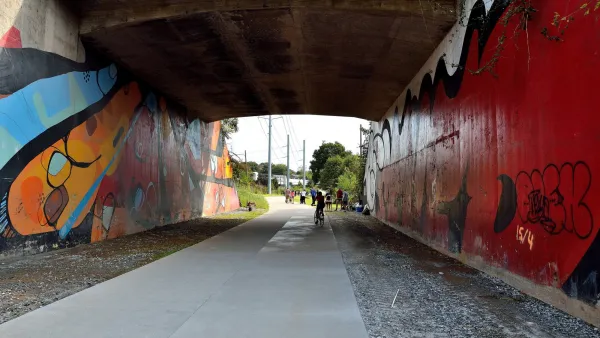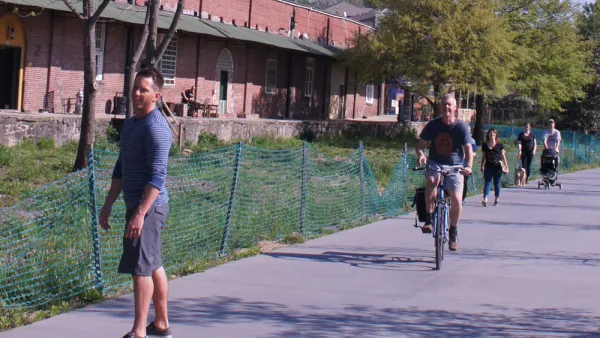A program to pay property-tax increases of nearby homeowners is welcome, but "about ten years too late," one advocate says.

Concerns about affordable housing, gentrification and displacement have accompanied the development of the Atlanta BeltLine since its earliest days. The vision for the project — a 22-mile multi-use trail built on an old railway line looping the entire city of Atlanta — was so clear a catalyst for rising real estate value that the original development plan, completed in 2005, included a goal of building 5,600 workforce housing units to mitigate the impacts of gentrification. Now, with more than half the time elapsed before the projected completion date of 2030, the BeltLine is still scrambling to make good on the promise of affordable housing. And some advocates say too much damage has already been done in terms of displacement, runaway home values, and speculative investment.
Late last year, the Atlanta BeltLine Partnership and Atlanta Beltline, Inc., launched a Legacy Resident Retention Program meant to help existing homeowners stay in their homes as property values, and taxes, continue to rise. The program is aimed at homeowners who have lived in and occupied their homes since at least 2017 and who earn less than 100% of area median income, which in Atlanta is $79,700 for a family of four. The program will cover the increased cost of property taxes for eligible homeowners through 2030. It’s open to people living in a handful of neighborhoods in south and west Atlanta where new BeltLine trails are expected to be completed in the next few years.
The groups running the program expect that some 2,500 homeowners are eligible in the targeted area, and that the program could cost $12.5 million over the next decade, says Rob Brawner, executive director of the Atlanta BeltLine Partnership, a nonprofit that helps guide the implementation of the BeltLine plan. So far, they’ve raised $500,000 from the electric utility Georgia Power, and $200,000 from Bank of America. To date, 128 homeowners have applied to the Legacy Resident Retention Program and 21 have been approved. It’s a small start, Brawner says, but the groups are looking for more funders, and being careful only to commit to those applicants that they know they can assist through the next ten years.
“We know that the long-term solution for this is not for philanthropy to indefinitely pay people’s property-tax increases,” Brawner says. “The long-term solution is a tax policy solution … That’s going to take some time, and we couldn’t afford to lose people [in the meantime].”
FULL STORY: The Atlanta BeltLine Wants to Prevent Displacement of Longtime Residents. Is it Too Late?

National Parks Layoffs Will Cause Communities to Lose Billions
Thousands of essential park workers were laid off this week, just before the busy spring break season.

Retro-silient?: America’s First “Eco-burb,” The Woodlands Turns 50
A master-planned community north of Houston offers lessons on green infrastructure and resilient design, but falls short of its founder’s lofty affordability and walkability goals.

Delivering for America Plan Will Downgrade Mail Service in at Least 49.5 Percent of Zip Codes
Republican and Democrat lawmakers criticize the plan for its disproportionate negative impact on rural communities.

Test News Post 1
This is a summary

Test News Headline 46
Test for the image on the front page.

Balancing Bombs and Butterflies: How the National Guard Protects a Rare Species
The National Guard at Fort Indiantown Gap uses GIS technology and land management strategies to balance military training with conservation efforts, ensuring the survival of the rare eastern regal fritillary butterfly.
Urban Design for Planners 1: Software Tools
This six-course series explores essential urban design concepts using open source software and equips planners with the tools they need to participate fully in the urban design process.
Planning for Universal Design
Learn the tools for implementing Universal Design in planning regulations.
EMC Planning Group, Inc.
Planetizen
Planetizen
Mpact (formerly Rail~Volution)
Great Falls Development Authority, Inc.
HUDs Office of Policy Development and Research
NYU Wagner Graduate School of Public Service





























